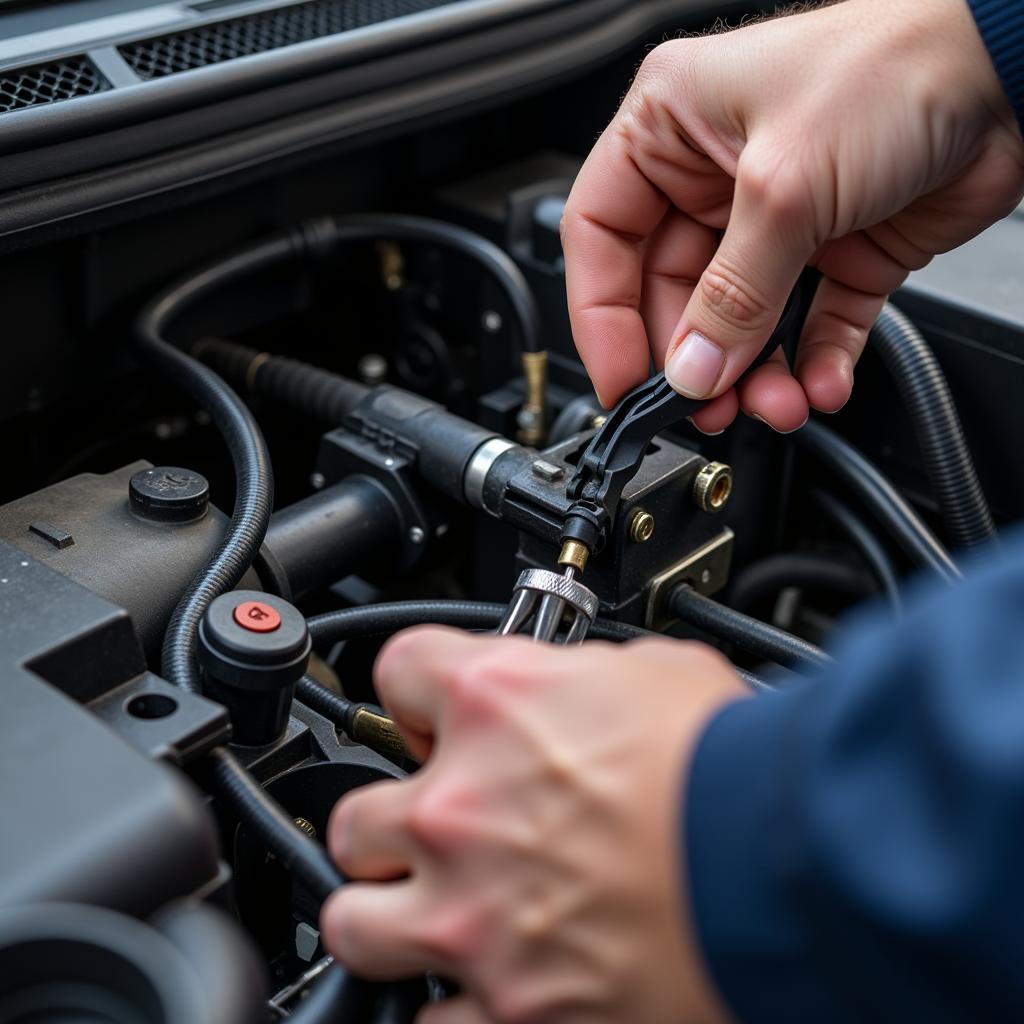A car seat that won’t adjust can be a real pain, impacting both comfort and safety. Whether it’s the seat back, height, or lumbar support that’s stuck, this guide will help you diagnose and fix the problem. We’ll cover everything from simple DIY solutions to more complex repairs that might require professional help. Let’s get your car seat moving again! You might find some helpful tips in our article on how to fix a car seat motor.
Common Causes of a Car Seat That Won’t Adjust
Several factors can cause a car seat to become stuck. These range from simple obstructions like something lodged in the tracks to more serious issues like a broken motor or damaged cables. Sometimes, the problem is as simple as a fuse. Other times, it could be a more complicated electrical issue.
- Mechanical Issues: Worn or broken components within the seat’s adjustment mechanism, such as gears, cables, or levers, are often the culprits. Rust and corrosion can also seize up moving parts.
- Electrical Problems: If your car seat is power-adjustable, a faulty switch, motor, or wiring harness could be preventing it from moving. A blown fuse is another common electrical issue.
- Obstructions: Sometimes, something as simple as a coin, pen, or piece of debris can get lodged in the seat tracks and prevent adjustment.
- Seat Frame Damage: In rare cases, a bent or damaged seat frame can interfere with the adjustment mechanism.
Troubleshooting and Fixing a Manual Car Seat
If you have a manual car seat, start by checking for any obvious obstructions in the seat tracks. Remove anything you find. Next, try lubricating the tracks with a silicone-based lubricant. This can often free up sticky mechanisms. If the lever itself feels loose or broken, you might need to replace it. This usually involves removing the seat cover and accessing the lever mechanism. For more complex issues, consult a professional mechanic. If you are dealing with twisted car seat straps, check out our guide on how to fix twisted car seat straps.
Troubleshooting and Fixing a Power Car Seat
Power car seats offer convenience, but they also introduce more potential points of failure. First, check the fuse box. A blown fuse is an easy fix. Next, inspect the wiring harness for any damage or loose connections. If everything looks okay, the problem might be with the switch or the motor itself. Testing these components often requires a multimeter and some electrical know-how. If you are not comfortable working with electrical systems, it’s best to seek professional help. You can find information about repairing power car seat motors in our guide on how to fix a car seat motor.
When to Call a Professional
While many car seat adjustments can be handled with some DIY know-how, some situations require professional assistance. If you’ve tried troubleshooting and the problem persists, or if you’re uncomfortable working with electrical systems or complex mechanical parts, it’s best to take your car to a qualified mechanic. Don’t hesitate to call if you’re unsure. Safety is paramount.
“A properly functioning car seat is essential for safety and comfort. Don’t compromise on either,” says Alex Johnson, a certified automotive technician with over 20 years of experience.
Preventing Future Problems
Regular maintenance can help prevent car seat adjustment issues. Keep the tracks clean and free of debris. Lubricate the moving parts periodically with a silicone-based lubricant. Avoid slamming the seat back or forcing the adjustments. These simple steps can significantly extend the life of your car seat’s adjustment mechanism.
“Regular maintenance can save you time, money, and frustration in the long run,” adds Alex Johnson.
Conclusion
Fixing a car seat that doesn’t adjust can be straightforward or complex, depending on the cause. By understanding the potential issues and following the troubleshooting steps outlined in this guide, you can often resolve the problem yourself. However, remember that safety is always the top priority. If you’re unsure about anything, don’t hesitate to contact a qualified mechanic. You might be interested in our review of the Cybex Pallas 2-fix junior car seat with ultra-safe base. Need help? Connect with us at AutoTipPro at +1 (641) 206-8880 or visit our office at 500 N St Mary’s St, San Antonio, TX 78205, United States.
FAQ
- What is the most common reason a car seat won’t adjust? Obstructions in the tracks, a faulty motor (for power seats), or a broken cable/lever (for manual seats).
- Can I fix a power car seat myself? Yes, if you have basic electrical skills. However, for complex problems, consult a professional.
- What type of lubricant should I use on car seat tracks? A silicone-based lubricant is recommended.
- How often should I lubricate my car seat tracks? Every few months or as needed. If you notice the seat sticking, it’s time to lubricate.
- Is it safe to drive with a car seat that doesn’t adjust? It depends. If the seat is in a safe and comfortable position, you might be able to drive temporarily. However, if the seat is in an unsafe position, it’s crucial to get it fixed before driving. Learn more about the Cybex Solution M Fix car seat. What if my car is leaking transmission fluid after I fixed it?
- How much does it typically cost to fix a car seat adjustment mechanism? The cost varies depending on the problem and the make and model of your car. It can range from a few dollars for a new fuse to several hundred dollars for a new motor.
- How can I prevent my car seat from getting stuck in the future? Regular cleaning and lubrication can help prevent problems. Also, avoid forcing the adjustments or slamming the seat back.






Leave a Reply